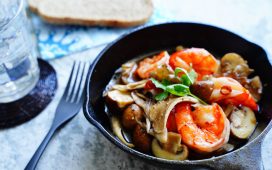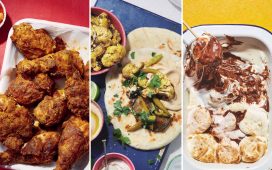LOS ANGELES — Using the edge of a carbon-steel razor blade, Antonio Morales scrapes pieces of browning onion from a wide, sizzling flat top.
Every day, starting at around 5 p.m., he modifies the traditions he brought with him from Guatemala to Los Angeles, adapting his food to the city’s most accommodating form: the taco.
Mr. Morales is meticulous, his blade searching constantly so that no bitterness reaches his tacos, assembled on doubled-up corn tortillas with slow-cooked shredded beef shoulder, juicy with rendered fat and lightly caramelized drippings, and finished with pickled sliced cabbage.
He is one of about 50 or so vendors who gather on the corner of South Bonnie Brae and Sixth Streets, in the Westlake neighborhood of Los Angeles, to form the city’s Guatemalan night market.
Other vendors pile a similar topping of beef and onion on pudgy, crisp-edged rounds of fried masa, with crumbly cheese and salsa, to make teeny, delicious and far more traditional garnachas.
They fry battered chicken on the bone and serve it with thick, heavily sauced fries. They blister many kinds of gleaming, leaf-wrapped tamales over charcoal in makeshift stoves.
The market, which appears stall by improvised stall late each afternoon, feeds hundreds of people. Then each night, it’s dismantled, making way for the block’s storefront businesses — fast food, mini marts and laundromats.
Most of the vendors speak Spanish or K’iche’, an indigenous language from the central highlands of Guatemala, and sometimes both. With their handmade, generously portioned, inexpensive foods, they cater to the growing community of Guatemalan-Angelenos — more than 250,000 people, the largest group outside of Guatemala.
On a recent Sunday, a young teenage couple in identical black hoodies sat side by side on the wall, swinging their legs and eating cheesy pupusas. An envoy from the church down the street approached a few men, still in their work clothes, who focused instead on their steamy clamshell containers. Happy children trailed behind their families, eating fries one by one from greasy bags, stopping to admire the night heron perched above a community mural.
By 7 p.m., Angelina Mateos was busy, carefully unwrapping her tamales de arroz con pollo onto plates. Regulars to the market know to arrive early for Ms. Mateos’s delicate, soupy-textured tamales made not from masa but rice, hiding tender pieces of chicken on the bone and splashed with a thin, floral hot sauce.
She often sells out within just a couple of hours, smiling and apologizing to disappointed latecomers as she pushes her granny cart out of the narrow passageway. But there is plenty of consolation from other cooks: pacaya palm heart fritters with beans, rice and macaroni salad; a sticky cow hoof soup; tostadas layered with crumbled beef and a mayonnaise-dressed salad of peas and carrots.
Ms. Mateos comes from the highlands of western Guatemala, and has lived in the United States since the early 1990s. Like many immigrants from Central America who started to arrive in Los Angeles beginning in the 1980s, escaping violence and political upheaval, she found a cultural hub in Westlake.
Vendors selling food on city sidewalks have worried in the past about criminal charges, fines and, particularly since the election of President Trump, detention by immigration authorities. But last fall, after years of local activism, a bill was signed decriminalizing street vending across California, and the Los Angeles City Council voted to legalize it.
On weekends, even more vendors appear. The vats of hot oil are precarious, balanced over stoves on the pavement, or in retrofitted shopping carts filled with charcoal, held in place by wads of crushed aluminum foil tucked under the wheels. The setup may appear rudimentary, but the frying that happens in this space is an art.
It’s most evident at the stalls selling pollo y papas fritas, where cooks brown large quantities of chicken and thickly cut fries, but work in small batches so what you order is still crisp, almost too hot to touch. If you say yes to everything on top, that means swirls of spicy ketchup, mayonnaise and a mild green salsa, which quickly amalgamate into a far more messy and powerful super sauce.
For the day laborers who head to the market at the end of their shifts, these renditions of pollo y papas fritas, served outside among the city’s Guatemalan’s community, aren’t just filling, satisfyingly crunchy and well seasoned. They’re also more affordable than the fried chicken at Pollo Campero, a Guatemalan chicken chain down the street.
And they’re sold alongside a range of regional specialties from back home that can be harder to find, like paches, the potato tamales stained red with mild chiles, and pepián, the stew practically creamy with finely ground pumpkin seeds.
If ending with something sweet is important, the cold aguas de cremas have the texture of melting ice cream, voluptuous and thick, flavored with vanilla or coconut. You could share one between two, maybe even three people.
But the market’s essential sweet is a fried platano. Big plantains are deeply browned in oil and served burn-your-mouth hot with a squiggle of salty cream, or stuffed with beans and fried. Either way, the best vendors take their time, slowly turning the fruit in oil until it’s dark and crackled, and the center is as soft and chewy as caramel.
Don’t get your plantain to go. Trapped in a container, it’ll sweat, undoing all that attentive frying. Instead, find a nook where you can wait with the crowd. In a minute or two, the plantain will be cool enough to eat right here.
Guatemalan Night Market, 1834 West 6th Street, Los Angeles; daily starting at 5 p.m.





